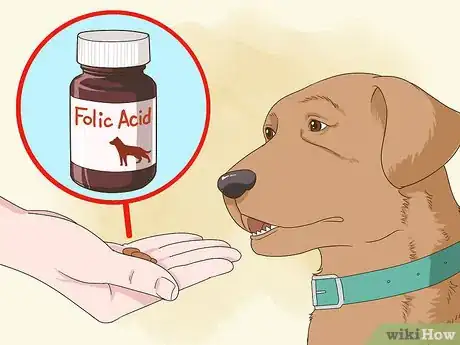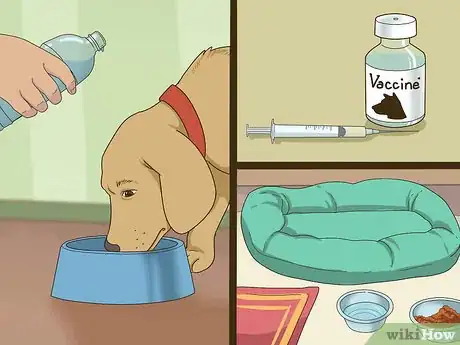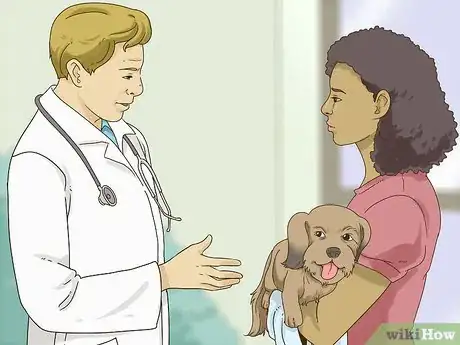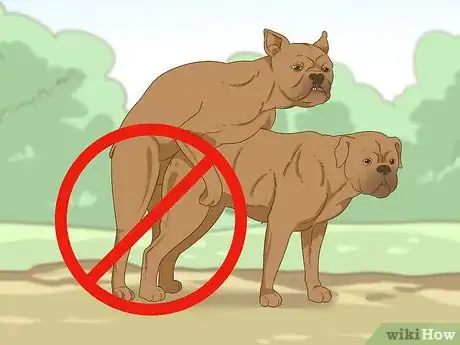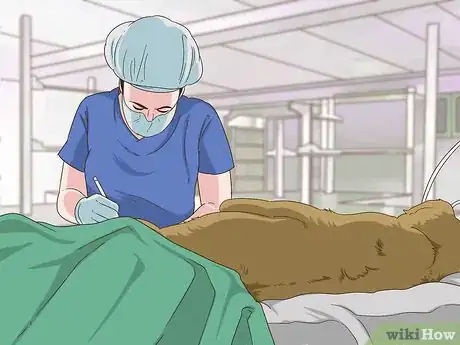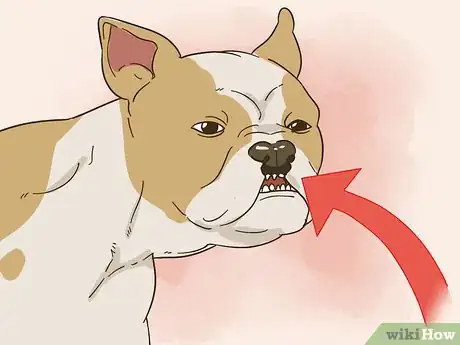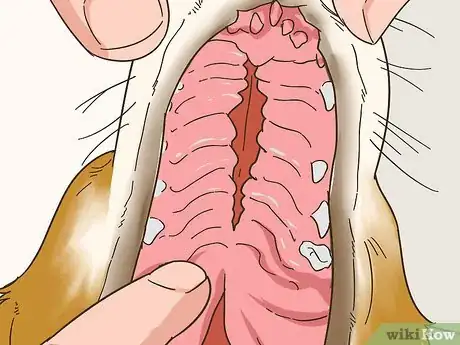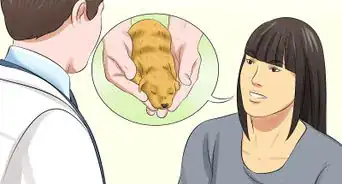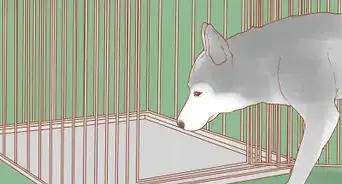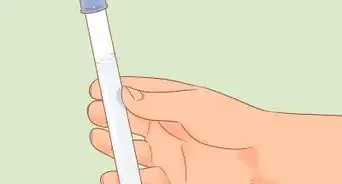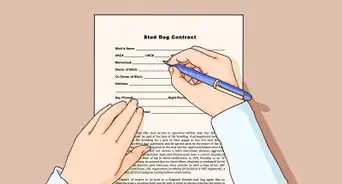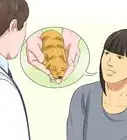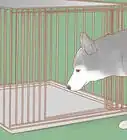This article was co-authored by April Power. April Power is a Dog Breeder and the Owner of Power Goldendoodles in Boise Idaho. She places her puppies all around the United States, specializing in breeding English Teddybear Goldendoodle puppies. In June 2020, We Love Doodles named Power Goldendoodles as one of the 9 Best Goldendoodle breeders who sell in California.
This article has been viewed 21,232 times.
A cleft palate is the result of improperly formed face or jaw features during a dog’s fetal development. In particular, different parts of the hard or soft tissues at the roof of the dog’s mouth fail to fuse together properly. Dogs born with a cleft palate often struggle to nurse, and are more susceptible to various infections. There are various factors - including the mother’s nutritional intake, health, and exposure to poison - that increase the likelihood of a dog being born with a cleft palate, but a dog’s genetic makeup is the most determinant factor.
Steps
Preventing Cleft Palates in Dogs
-
1Ensure your pregnant dog eats a healthy diet. Aside from a dog’s genetic make up, the health and well-being of it mother during pregnancy are also extremely important. During the first two trimesters - or roughly 40 days - of the dog’s pregnancy, her nutritional requirements are that same as that of a healthy adult dog. The puppies really begin to develop physically in the third trimester, meaning you’ll need to provide more food for the mother dog.[1]
- During the first two trimesters, monitor your dog’s weight and behavior and feed her normally. If she begins to lose any weight at all, slowly increase the amount you are feeding her.
- Week 6 through week 8 of your dog’s pregnancy demand particularly high energy output for the mother. She will need anywhere from 30-60% more food than normal, depending in party on the size of her litter. She also may struggle to eat, as she will be quite literally filled with puppies.
- Provide a dog food designed to be highly digestible during the third semester in particular. These foods are often labeled as puppy, growth, or development foods. Provide small meals throughout the day to allow the mother to eat whenever she is able.
-
2Provide folic acid supplements to your pregnant dog. Folic acid is a nutrient that has proven to be especially important to puppies’ healthy development. In fact, supplements of this nutrient alone will reduce the risk of cleft palate, even in genetically predisposed breeds.
- Give your pregnant dog 2.5mg tablets pf folic acid every day for the first three weeks of their pregnancy.
Advertisement -
3Protect your pregnant dog from infection. Viral infections in a mother dog may increase the risk of her puppies having cleft palates. Further, pregnant dogs are also more susceptible to infection. You can help prevent infection by keeping your dog up-to-date on their vaccinations, allowing them to only drink clean, fresh water, and regularly cleaning their living space, especially any outdoor areas in which they regularly defecate.[2]
- If your dog is behind on their vaccinations and become pregnant, talk to your veterinarian about potentially vaccinating the dog.
-
4Keep your pregnant dog away from potential poisons. Exposure of a pregnant dog to any toxic substances may increase the likelihood that her puppies will have cleft palates. As such, make sure your dog does not get anything that may poison her during her pregnancy, such as household chemicals, prescription drugs, etc.
-
5Medicate a pregnant dog carefully. There are many medications that are commonly provided to dogs that are unsafe to provide to a pregnant dog. For instance, do not give a pregnant dog corticosteroids, as they may be especially likely to cause a cleft palate.
- Talk to your vet about any medications you may be providing to your dog. Ask something like, “Do these medications place the health of her puppies at risk?”[3]
Avoiding Genetic Risks While Breeding
-
1Determine if your dog's breed is at particular risk. While any dog breed of dog can be born with a cleft palate, purebred dogs suffer from a higher incidence of this developmental issue. Brachycephalic breeds, which tend to have short or effectively absent muzzles, are the most commonly affected. The specific breeds that are at greatest risk include Boston terriers, Pekingese, bulldogs, miniature schnauzers, beagles, cocker spaniels, and dachshunds.[4]
-
2Do not breed dogs that carry the genes for cleft palates. More to the point, do not breed dogs that were born with cleft palates or parents of offspring with cleft palates. It is likely that the gene for particular types of cleft palate is recessive, and can be carried by male as well as female dogs. As such, dogs that were born with cleft palates and their parents are all likely carries of genetic material that is likely to cause cleft palates in their offspring.
-
3Spay or neuter dogs with cleft palates. Not all pregnancies are intended. Accordingly, the best way to remove the genetic defects that cause cleft palates from the gene pool is by neutering or spaying the dogs that carry the genes corresponding with these defects. It is cruel to breed dogs knowing that the puppies are especially likely to suffer from genetic maladies.
Diagnosing and Treating Cleft Palates
-
1Recognize symptoms of a cleft palate. There are many different types and degrees of a cleft palate. Many are immediately apparent, causing teeth and gums to show unnaturally, or a nostril to be misshapen. Secondary cleft palates may be hidden within the mouth, but can still put a puppy at considerable health risk.[5]
- Signs that may indicate a secondary cleft palate include sneezing and snorting during nursing or eating, a runny nose after eating, coughing or gagging while drinking water, stunted growth, and breathing issues.
-
2Check for a cleft palate manually. You can peer into a puppy's mouth or reach within it to check for a cleft palate in the hard palate. Simply look at the roof of the dog’s mouth or run your finger along this area. Look or feel for signs that the palate is not entirely fused. A puppy will likely have to be anesthetized for check their soft palate, as this is located further back in the throat.[6]
- Whether or not you are able to find evidence of a cleft palate yourself, take your dog to the vet if you are concerned about their health.
-
3Take care of a puppy after treatment. A puppy with a cleft palate may need surgery. Unfortunately, the surgery will likely be risky. Obey all of your veterinarian's directions following a pet’s surgery, which will likely include the following:[7]
- Provide antibiotics in the event of an infection.
- Have the puppy wear an e-collar for at least a week to prevent them from rubbing their face.
- Feed the puppy soft, wet food that has been blended for 2-4 weeks following the surgery.
- Withhold hard food or toys for a month following the surgery.
References
- ↑ http://www.vcahospitals.com/main/pet-health-information/article/animal-health/feeding-the-pregnant-dog/10035
- ↑ http://www.pet-informed-veterinary-advice-online.com/pregnant-dog.html
- ↑ http://www.peteducation.com/article.cfm?c=2+2109&aid=856
- ↑ https://www.acvs.org/small-animal/cleft-palate
- ↑ https://www.acvs.org/small-animal/cleft-palate
- ↑ https://www.acvs.org/small-animal/cleft-palate
- ↑ https://www.acvs.org/small-animal/cleft-palate
About This Article
To reduce the chances of breeding puppies with cleft palates, give the mother a well-balanced diet during her pregnancy. She’ll need more food as the pregnancy progresses to support her growing babies. You should also give her folic acid supplements to ensure that the puppies develop properly. Additionally, you can keep the mother and her growing puppies healthy by staying up-to-date on vaccines, keeping the dog’s eating and living areas clean, and keeping toxic substances out of reach. If your dog gets sick, work with your vet to develop a treatment plan that’s safe for both the mother and puppies. Scroll down for more tips from our Veterinarian co-author, including how to minimize genetic risks when breeding dogs!

